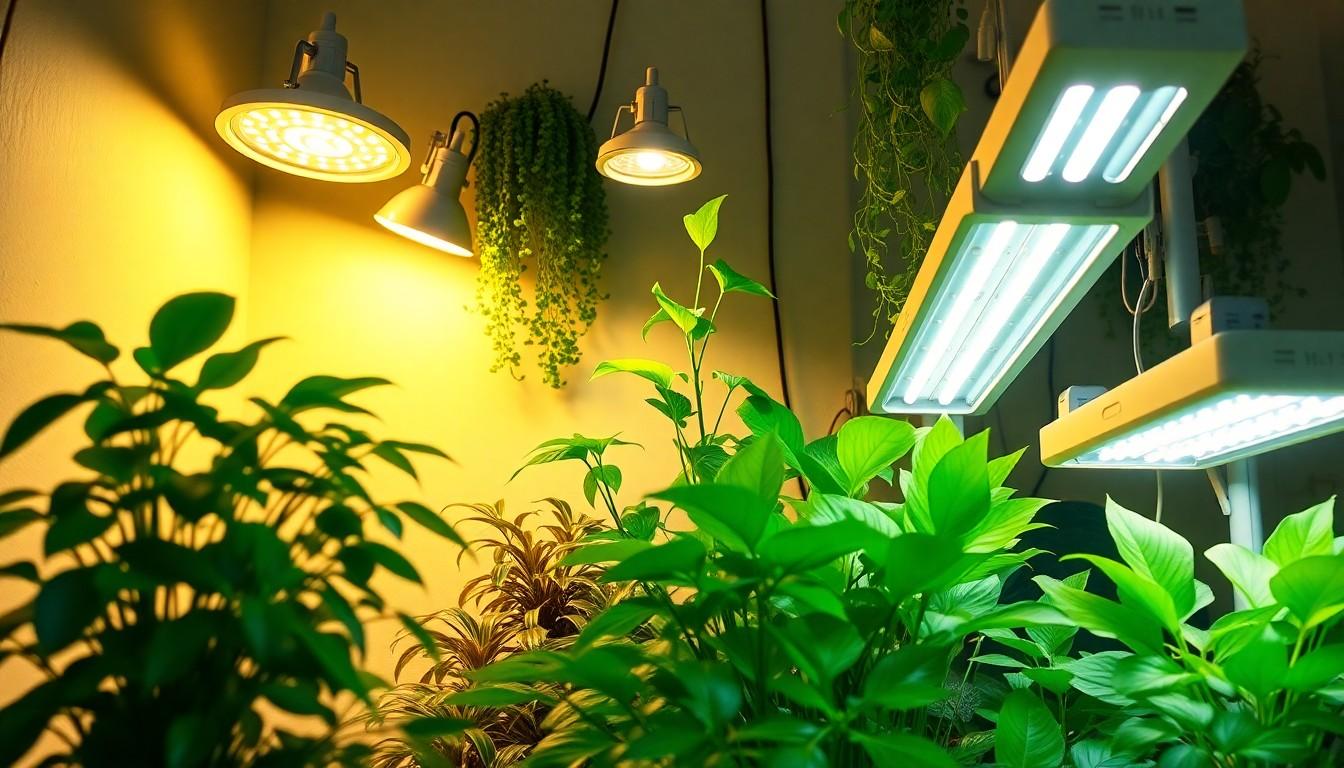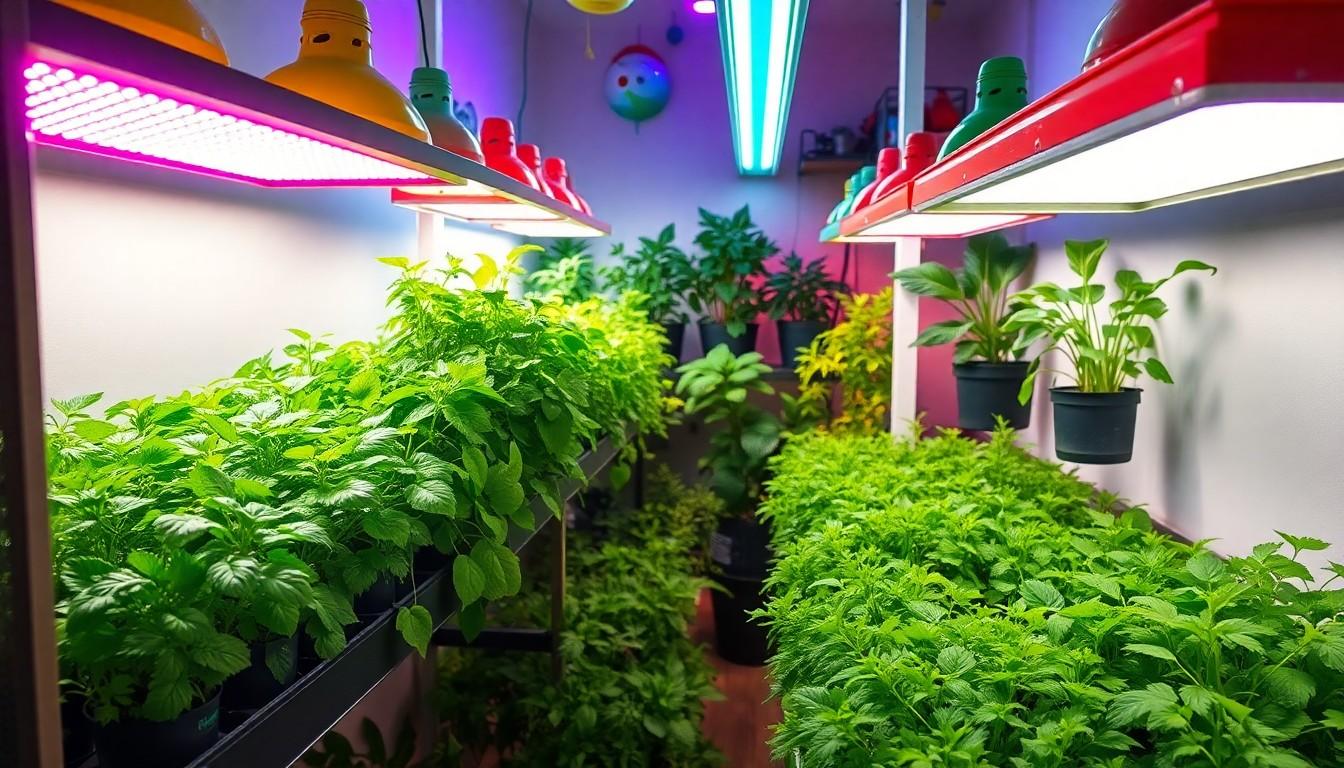Indoor gardening is like a secret club where plants thrive under the glow of grow lamps. These magical devices transform dark corners into lush jungles, ensuring every leaf gets its fair share of sunlight. If you’ve ever watched a plant droop in despair, you know the struggle is real. But fear not—grow lamps are here to rescue those sad greens and turn them into thriving beauties.
Overview of Grow Lamps for Indoor Plants
Grow lamps serve as crucial tools for indoor gardening. These devices provide light wavelengths essential for plant growth, bridging the gap when natural sunlight is insufficient. Various types of grow lamps exist, each designed to fulfill different plant needs.
LED grow lamps use energy-efficient technology, consuming less power while emitting ample light. Their longevity and low heat output make them popular choices among indoor gardeners. Fluorescent grow lamps, on the other hand, offer affordable lighting options and are effective for seedlings and low-light plants.
Incandescent grow lights, while less common, have high wattage and can work for certain plant types, although their heat production requires caution. Horticultural grow lights, specifically made for indoor plants, provide a spectrum tailored to promote photosynthesis and growth.
Light intensity plays a vital role in plant health. High-intensity light encourages faster growth and larger yields, whereas low-intensity light supports more delicate species. It’s essential to position grow lamps at optimal distances from plants to prevent burn while maximizing light absorption.
Usage duration significantly impacts plant growth as well. Providing 12 to 16 hours of light daily mimics natural sun exposure, promoting healthy photosynthesis. Monitoring plant response to grow lamps ensures that adjustments occur as needed for optimal results.
Understanding these key aspects of grow lamps transforms indoor gardening experiences, ensuring plants thrive in varying environments. Proper light supplementation leads to vibrant, healthy indoor plant displays.
Types of Grow Lamps

Different types of grow lamps cater to various indoor gardening needs. Understanding these options helps gardeners choose the right lighting for their plants.
LED Grow Lamps
LED grow lamps provide energy efficiency and long lifespans, making them popular among indoor gardeners. They emit specific light wavelengths, promoting photosynthesis and growth. Available in full-spectrum options, they mimic natural sunlight. These lamps produce minimal heat, reducing the risk of plant damage. Additionally, LED grow lamps consume less electricity compared to other types, resulting in lower energy bills. Their versatility allows for use in small spaces or large setups.
Fluorescent Grow Lamps
Fluorescent grow lamps are ideal for seedlings and young plants due to their affordable price and ease of use. They produce low heat, making them safe for close positioning near plants. These lamps are available in various sizes, including compact fluorescent lamps (CFLs). Their effectiveness lies in their full-spectrum light output, essential for plant growth. Orange and blue tones often benefit different plant stages, promoting healthy development. Fluorescent lamps are suitable for hobbyists and those on a budget.
HID Grow Lamps
HID grow lamps deliver intense light, suitable for larger indoor setups. High-intensity discharge options include metal halide and high-pressure sodium lamps. Metal halide bulbs provide a blue spectrum for vegetative growth. In contrast, high-pressure sodium bulbs enhance flowering and fruiting phases. Optimizing light placement ensures maximum coverage and efficient energy use. These lamps generate significant heat, necessitating proper ventilation. Gardeners utilizing HID grow lamps often achieve robust yields.
Benefits of Using Grow Lamps for Indoor Plants
Grow lamps offer significant advantages for indoor gardening, providing essential light for optimal plant growth.
Enhanced Photosynthesis
Grow lamps facilitate enhanced photosynthesis by supplying the right spectrum of light. Plants absorb specific wavelengths, particularly red and blue light, which stimulate growth and flowering. With the right grow lamp setup, plants can achieve higher rates of photosynthesis, leading to vigorous growth and larger yields. Energy-efficient LED lamps produce light with minimal heat, ensuring that plants remain at optimal temperatures. Inadequate natural light can hinder plant development, but grow lamps bridge this gap effectively. By using grow lamps, indoor gardeners can observe healthier plants that exhibit robust foliage and vibrant flowers.
Year-Round Gardening
Grow lamps enable year-round gardening by overcoming seasonal light limitations. Many regions experience reduced sunlight during winter months, impeding plant growth. Grow lamps provide a consistent light source, allowing gardeners to cultivate plants regardless of the outside climate. With the ability to simulate natural daylight cycles, these lamps support continuous growth and flowering throughout the year. Additionally, grow lamps cater to various plant types, making it easier for gardeners to grow herbs, vegetables, and ornamental plants indoors. Easy management of light duration and intensity creates a flexible gardening environment that ensures plants thrive all year long.
How to Choose the Right Grow Lamp
Selecting the right grow lamp ensures that indoor plants receive the light they need to thrive. Understanding specific requirements helps in making the best choice for successful growth.
Consider Your Plant Type
Different plants have varying light needs. For instance, leafy greens typically thrive under fluorescent lamps, while flowering species benefit from the specific light spectrum of LED options. Succulents and cacti prefer bright light, making HID lamps suitable for their growth. Understanding a plant’s natural habitat guides the appropriate grow lamp choice, ensuring it receives ample light for photosynthesis and blooming.
Assess the Space Requirements
Evaluating the available space is crucial for effective lamp usage. Measure the area where plants reside to determine lamp size and light coverage. Consider vertical space for taller plants and ensure lamps can be adjusted as needed. For small areas, compact LED panels are efficient, while larger setups may necessitate multiple HID lamps to cover all plants adequately. Optimal space assessment maximizes light efficiency and plant health.
Best Grow Lamps for Indoor Plants
Grow lamps play a crucial role in nurturing indoor plants. Selecting the right lamp can enhance growth and overall health.
Top Recommendations
LED grow lamps lead the market, celebrated for energy efficiency and long lifespan. Numerous brands, like Spider Farmer and Viparspectra, offer powerful options tailored for various plant needs. Horticultural grow lights, such as those from Phlizon, provide full-spectrum lighting ideal for flowering plants. Fluorescent lamps from AgriON serve well for seedlings and delicate herbs with their gentle, low-heat output. Choosing a grow lamp that emits specific wavelengths is vital to ensure plants receive adequate light for photosynthesis.
Budget-Friendly Options
Affordability matters for many gardeners. The GE Grow Light and the Barrina LED grow light strip both deliver excellent performance without breaking the bank. Compact fluorescent lights often fit within tight budgets while still supporting plant growth effectively. Brands like SANSI offer energy-efficient bulbs that can brighten small spaces at a low cost. Understanding individual plant requirements ensures budget-friendly options provide sufficient light to stimulate growth and health.
Conclusion
Grow lamps are essential tools for indoor gardeners aiming to create thriving plant environments. By providing the right spectrum and intensity of light, these lamps support photosynthesis and promote healthy growth year-round.
Choosing the right type of grow lamp tailored to specific plants can make all the difference in achieving vibrant displays. With options ranging from energy-efficient LEDs to affordable fluorescent lights, there’s a solution for every gardener’s needs.
Understanding individual plant requirements and optimizing light exposure will ensure that indoor gardening becomes a rewarding and successful endeavor. Embracing the benefits of grow lamps opens up endless possibilities for cultivating a lush indoor garden.

